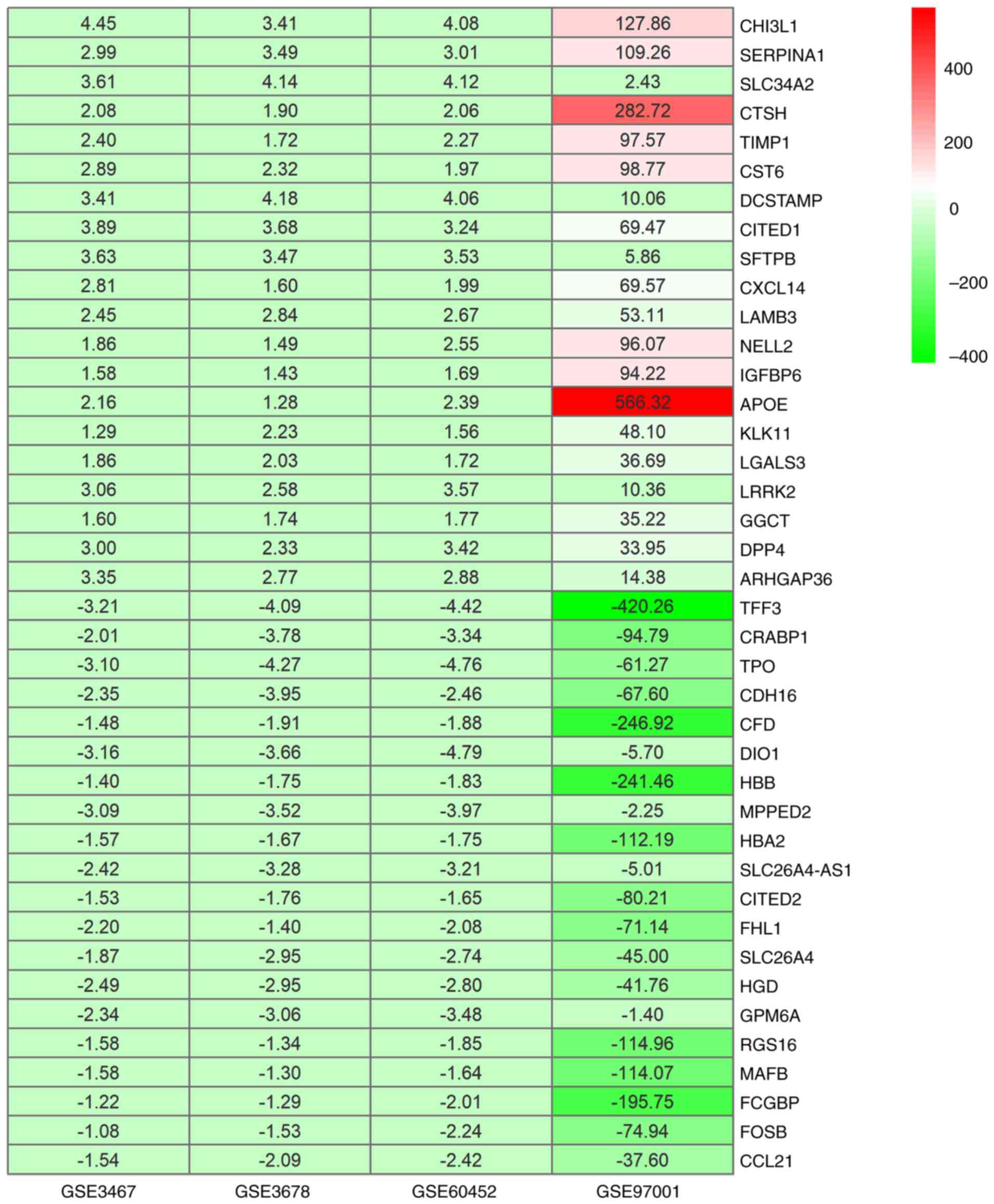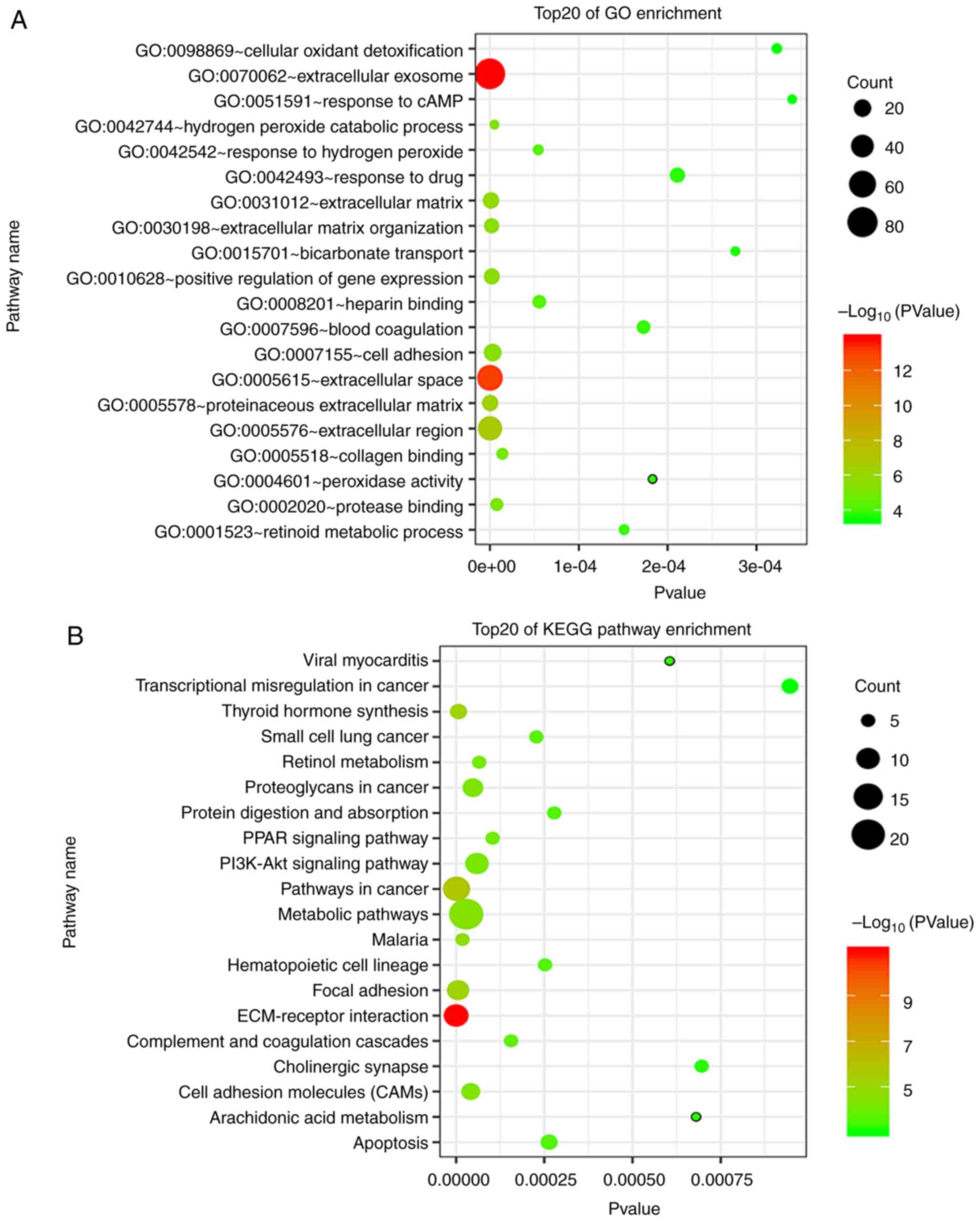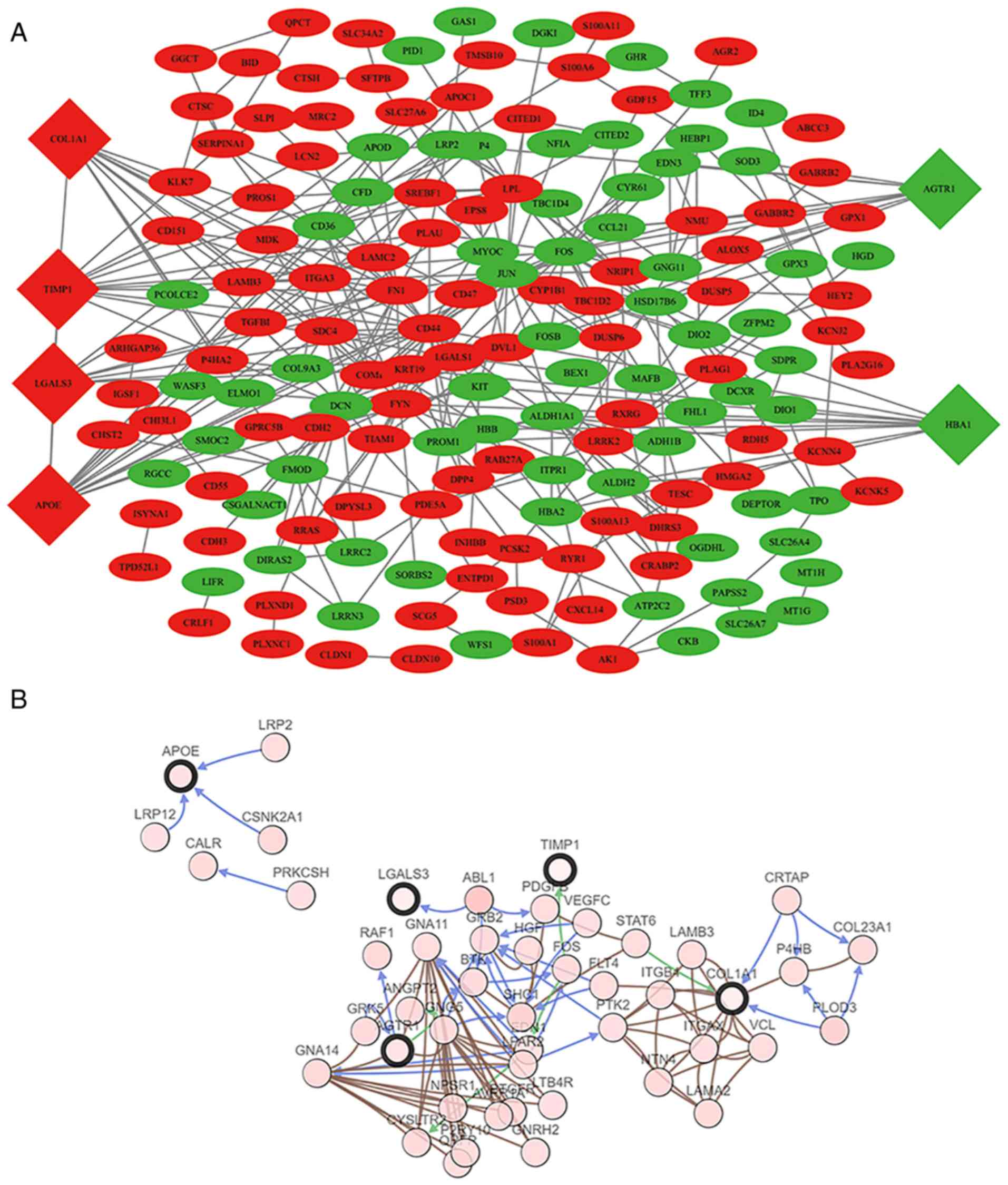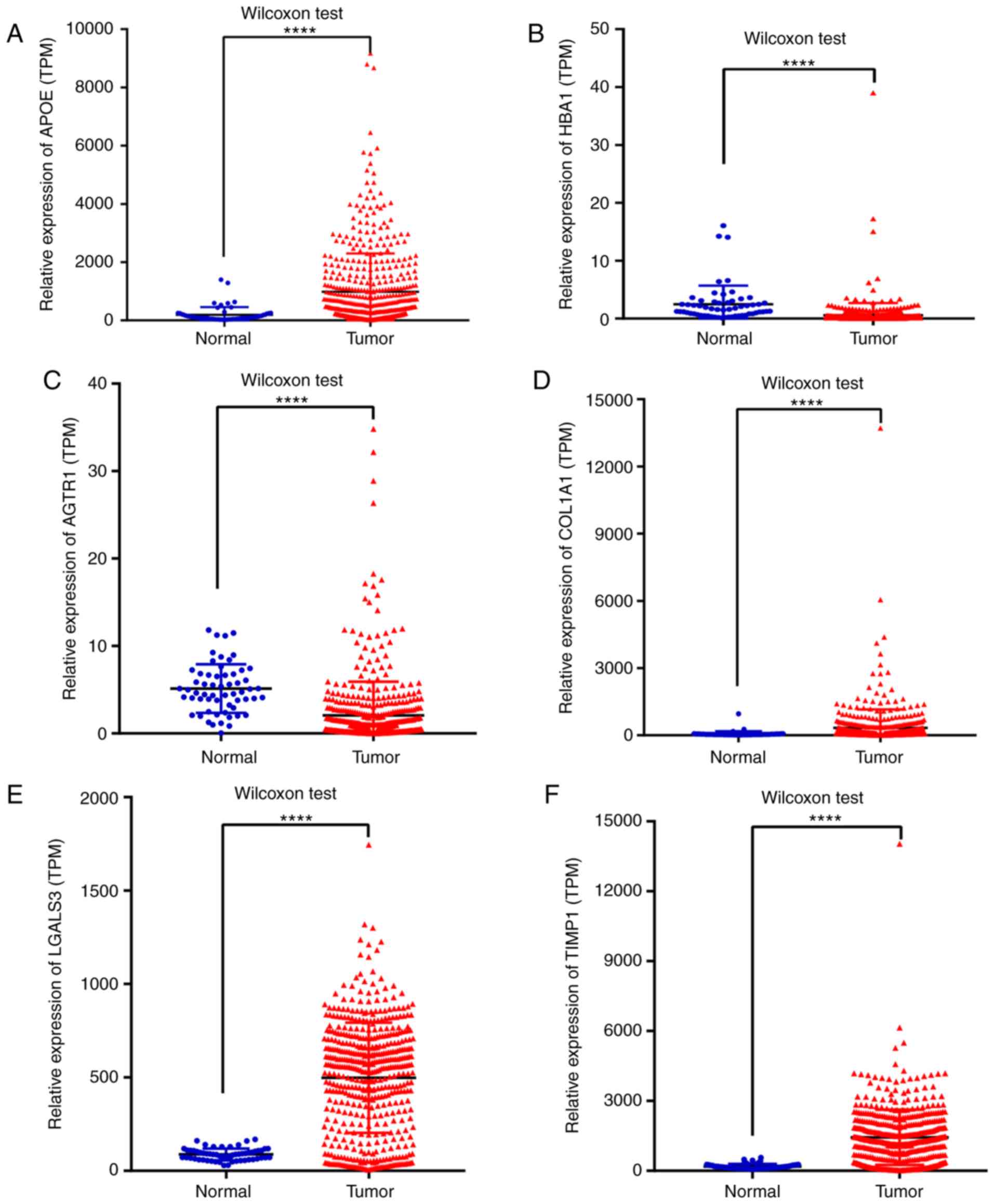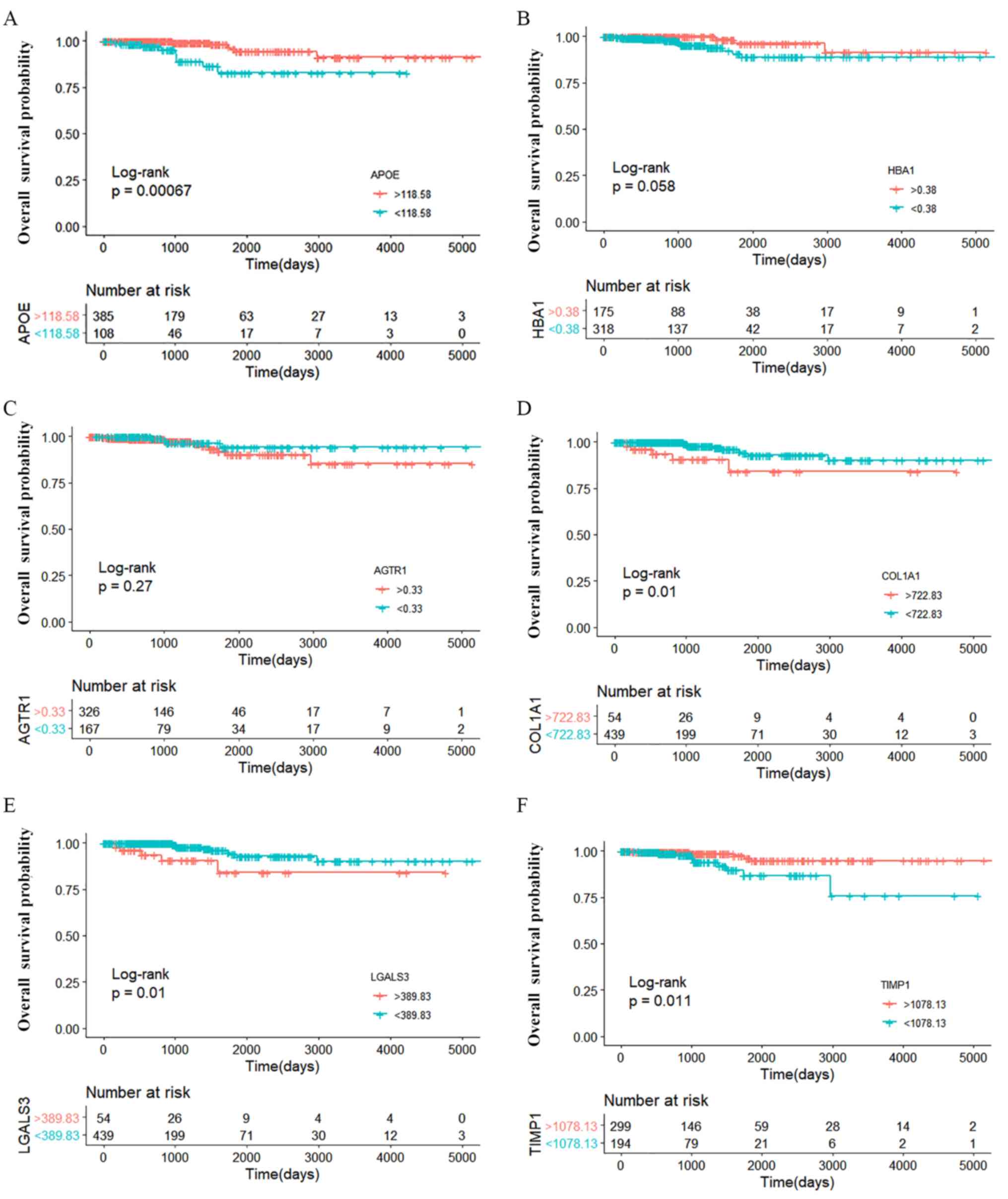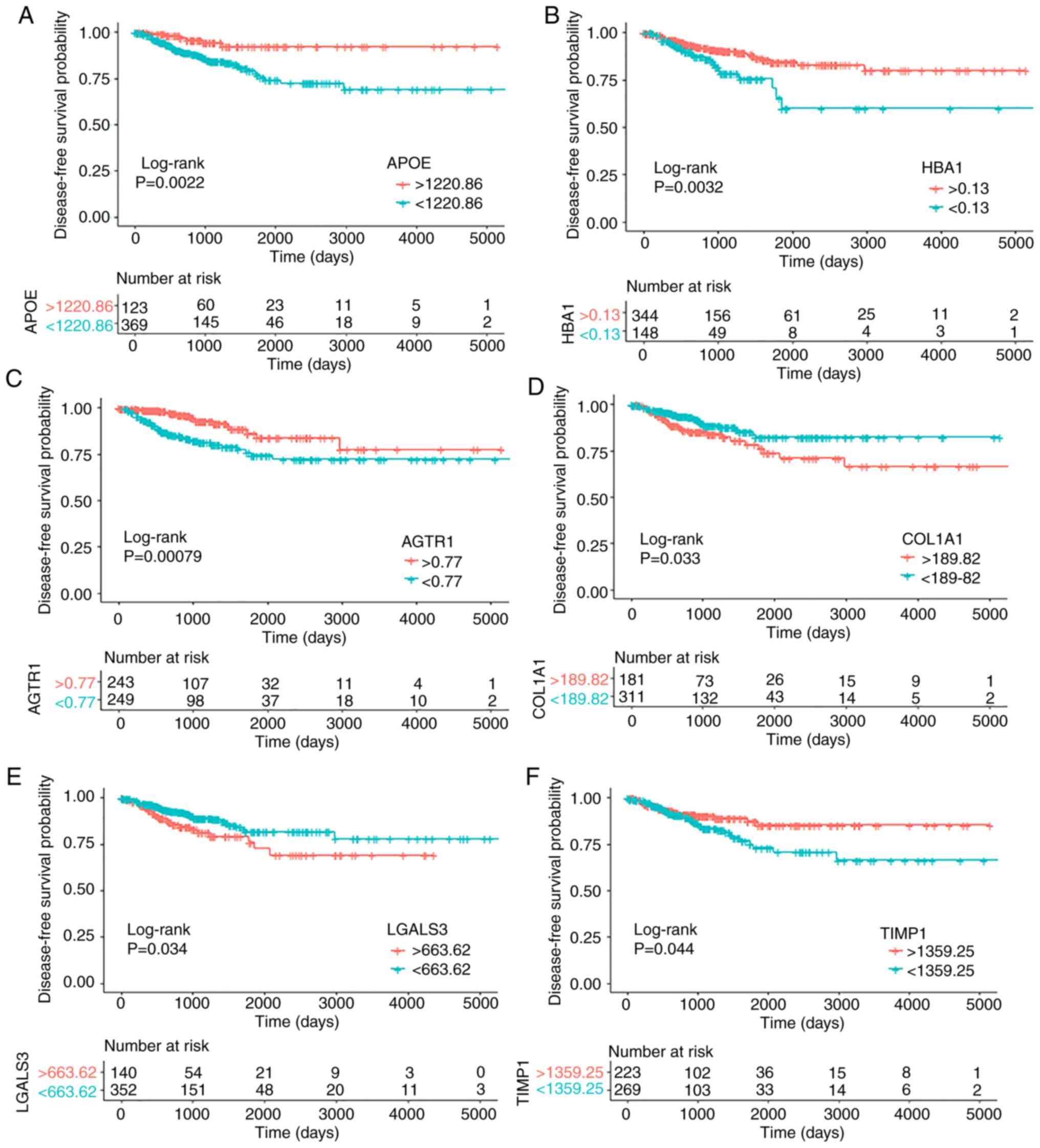|
1
|
Bray F, Ferlay J, Soerjomataram I, Siegel
RL, Torre LA and Jemal A: Global cancer statistics 2018: GLOBOCAN
estimates of incidence and mortality worldwide for 36 cancers in
185 countries. CA Cancer J Clin. 68:394–424. 2018. View Article : Google Scholar : PubMed/NCBI
|
|
2
|
Xing M, Haugen BR and Schlumberger M:
Progress in molecular-based management of differentiated thyroid
cancer. Lancet. 381:1058–1069. 2013. View Article : Google Scholar : PubMed/NCBI
|
|
3
|
Rusinek D, Pfeifer A, Krajewska J,
Oczko-Wojciechowska M, Handkiewicz-Junak D, Pawlaczek A,
Zebracka-Gala J, Kowalska M, Cyplinska R, Zembala-Nozynska E, et
al: Coexistence of TERT promoter mutations and the BRAF V600E
alteration and its impact on histopathological features of
papillary thyroid carcinoma in a selected series of polish
patients. Int J Mol Sci. 19:E26472018. View Article : Google Scholar : PubMed/NCBI
|
|
4
|
Kwak HY, Chae BJ, Eom YH, Hong YR, Seo JB,
Lee SH, Song BJ, Jung SS and Bae JS: Does papillary thyroid
carcinoma have a better prognosis with or without Hashimoto
thyroiditis? Int J Clin Oncol. 20:463–473. 2015. View Article : Google Scholar : PubMed/NCBI
|
|
5
|
Selmansberger M, Feuchtinger A, Zurnadzhy
L, Michna A, Kaiser JC, Abend M, Brenner A, Bogdanova T, Walch A,
Unger K, et al: CLIP2 as radiation biomarker in papillary thyroid
carcinoma. Oncogene. 34:3917–3925. 2015. View Article : Google Scholar : PubMed/NCBI
|
|
6
|
Liu Z, Cai J, Yu Y, Fang H, Si Y, Jankee
JJ and Shen M: Tumor abnormal protein as a novel biomarker in
papillary thyroid carcinoma. Clin Lab. 63:479–485. 2017. View Article : Google Scholar : PubMed/NCBI
|
|
7
|
Giordano TJ, Kuick R, Thomas DG, Misek DE,
Vinco M, Sanders D, Zhu Z, Ciampi R, Roh M, Shedden K, et al:
Molecular classification of papillary thyroid carcinoma: Distinct
BRAF, RAS, and RET/PTC mutation-specific gene expression profiles
discovered by DNA microarray analysis. Oncogene. 24:6646–6656.
2005. View Article : Google Scholar : PubMed/NCBI
|
|
8
|
Ciampi R, Knauf JA, Kerler R, Gandhi M,
Zhu Z, Nikiforova MN, Rabes HM, Fagin JA and Nikiforov YE:
Oncogenic AKAP9-BRAF fusion is a novel mechanism of MAPK pathway
activation in thyroid cancer. J Clin Invest. 115:94–101. 2005.
View Article : Google Scholar : PubMed/NCBI
|
|
9
|
Crescenzi A, Guidobaldi L, Nasrollah N,
Taccogna S, Cicciarella Modica DD, Turrini L, Nigri G, Romanelli F,
Valabrega S, Giovanella L, et al: Immunohistochemistry for
BRAF(V600E) antibody VE1 performed in core needle biopsy samples
identifies mutated papillary thyroid cancers. Horm Metab Res.
46:370–374. 2014. View Article : Google Scholar : PubMed/NCBI
|
|
10
|
Clinkscales W, Ong A, Nguyen S, Harruff EE
and Gillespie MB: Diagnostic value of RAS mutations in
indeterminate thyroid nodules. Otolaryngol Head Neck Surg.
156:472–479. 2017. View Article : Google Scholar : PubMed/NCBI
|
|
11
|
Fagin JA and Wells SA Jr: Biologic and
clinical perspectives on thyroid cancer. N Engl J Med.
375:23072016. View Article : Google Scholar : PubMed/NCBI
|
|
12
|
Lima CR, Geraldo MV, Fuziwara CS, Kimura
ET and Santos MF: MiRNA-146b-5p upregulates migration and invasion
of different Papillary Thyroid Carcinoma cells. BMC Cancer.
16:1082016. View Article : Google Scholar : PubMed/NCBI
|
|
13
|
Condello V, Torregrossa L, Sartori C,
Denaro M, Poma AM, Piaggi P, Valerio L, Materazzi G, Elisei R,
Vitti P and Basolo F: mRNA and miRNA expression profiling of
follicular variant of papillary thyroid carcinoma with and without
distant metastases. Mol Cell Endocrinol. 479:93–102. 2019.
View Article : Google Scholar : PubMed/NCBI
|
|
14
|
Chen F, Yin S, Zhu J, Liu P, Yang C, Feng
Z and Deng Z: lncRNA DGCR5 acts as a tumor suppressor in papillary
thyroid carcinoma via sequestering miR-2861. Exp Ther Med.
17:895–900. 2019.PubMed/NCBI
|
|
15
|
Matsumoto Y, Saito M, Saito K, Kanke Y,
Watanabe Y, Onozawa H, Hayase S, Sakamoto W, Ishigame T, Momma T,
et al: Enhanced expression of KIF4A in colorectal cancer is
associated with lymph node metastasis. Oncol Lett. 15:2188–2194.
2018.PubMed/NCBI
|
|
16
|
Liu C, Song YH, Mao Y, Wang HB and Nie G:
MiRNA-106a promotes breast cancer progression by regulating DAX-1.
Eur Rev Med Pharmacol Sci. 23:1574–1583. 2019.PubMed/NCBI
|
|
17
|
Lundgren S, Fagerstrom-Vahman H, Zhang C,
Ben-Dror L, Mardinoglu A, Uhlen M, Nodin B and Jirström K:
Discovery of KIRREL as a biomarker for prognostic stratification of
patients with thin melanoma. Biomark Res. 7:12019. View Article : Google Scholar : PubMed/NCBI
|
|
18
|
Edgar R, Domrachev M and Lash AE: Gene
Expression Omnibus: NCBI gene expression and hybridization array
data repository. Nucleic Acids Res. 30:207–210. 2002. View Article : Google Scholar : PubMed/NCBI
|
|
19
|
He H, Jazdzewski K, Li W, Liyanarachchi S,
Nagy R, Volinia S, Calin GA, Liu CG, Franssila K, Suster S, et al:
The role of microRNA genes in papillary thyroid carcinoma. Proc
Natl Acad Sci USA. 102:19075–19080. 2005. View Article : Google Scholar : PubMed/NCBI
|
|
20
|
Tarabichi M, Saiselet M, Tresallet C,
Hoang C, Larsimont D, Andry G, Maenhaut C and Detours V: Revisiting
the transcriptional analysis of primary tumours and associated
nodal metastases with enhanced biological and statistical controls:
Application to thyroid cancer. Br J Cancer. 112:1665–1674. 2015.
View Article : Google Scholar : PubMed/NCBI
|
|
21
|
Iacobas DA, Tuli NY, Iacobas S, Rasamny
JK, Moscatello A, Geliebter J and Tiwari RK: Gene master regulators
of papillary and anaplastic thyroid cancers. Oncotarget.
9:2410–2424. 2017.PubMed/NCBI
|
|
22
|
Diboun I, Wernisch L, Orengo CA and
Koltzenburg M: Microarray analysis after RNA amplification can
detect pronounced differences in gene expression using limma. BMC
Genomics. 7:2522006. View Article : Google Scholar : PubMed/NCBI
|
|
23
|
Dennis G Jr, Sherman BT, Hosack DA, Yang
J, Gao W, Lane HC and Lempicki RA: DAVID: Database for annotation,
visualization, and integrated discovery. Genome Biol. 4:P32003.
View Article : Google Scholar : PubMed/NCBI
|
|
24
|
Ashburner M, Ball CA, Blake JA, Botstein
D, Butler H, Cherry JM, Davis AP, Dolinski K, Dwight SS, Eppig JT,
et al: Gene ontology: Tool for the unification of biology. The gene
ontology consortium. Nat Genet. 25:25–29. 2000. View Article : Google Scholar : PubMed/NCBI
|
|
25
|
Kanehisa M, Furumichi M, Tanabe M, Sato Y
and Morishima K: KEGG: New perspectives on genomes, pathways,
diseases and drugs. Nucleic Acids Res. 45:D353–D361. 2017.
View Article : Google Scholar : PubMed/NCBI
|
|
26
|
Szklarczyk D, Morris JH, Cook H, Kuhn M,
Wyder S, Simonovic M, Santos A, Doncheva NT, Roth A, Bork P, et al:
The STRING database in 2017: Quality-controlled protein-protein
association networks, made broadly accessible. Nucleic Acids Res.
45:D362–D368. 2017. View Article : Google Scholar : PubMed/NCBI
|
|
27
|
Chin CH, Chen SH, Wu HH, Ho CW, Ko MT and
Lin CY: cytoHubba: Identifying hub objects and sub-networks from
complex interactome. BMC Syst Biol. 8 (Suppl 4):S112014. View Article : Google Scholar : PubMed/NCBI
|
|
28
|
Tan J, Qian X, Song B, An X, Cai T, Zuo Z,
Ding D, Lu Y and Li H: Integrated bioinformatics analysis reveals
that the expression of cathepsin S is associated with lymph node
metastasis and poor prognosis in papillary thyroid cancer. Oncol
Rep. 40:111–122. 2018.PubMed/NCBI
|
|
29
|
Asa SL, Giordano TJ and LiVolsi VA:
Implications of the TCGA genomic characterization of papillary
thyroid carcinoma for thyroid pathology: Does follicular variant
papillary thyroid carcinoma exist? Thyroid. 25:1–2. 2015.
View Article : Google Scholar : PubMed/NCBI
|
|
30
|
Wang K, Xu J, Li S, Liu S and Zhang L:
Population-based study evaluating and predicting the probability of
death resulting from thyroid cancer among patients with papillary
thyroid microcarcinoma. Cancer Med. 8:6977–6985. 2019. View Article : Google Scholar : PubMed/NCBI
|
|
31
|
Londero SC, Krogdahl A, Bastholt L,
Overgaard J, Pedersen HB, Hahn CH, Bentzen J, Schytte S,
Christiansen P, Gerke O, et al: Papillary thyroid carcinoma in
Denmark, 1996–2008: Outcome and evaluation of established
prognostic scoring systems in a prospective national cohort.
Thyroid. 25:78–84. 2015. View Article : Google Scholar : PubMed/NCBI
|
|
32
|
Rappa G, Puglisi C, Santos MF, Forte S,
Memeo L and Lorico A: Extracellular vesicles from thyroid
carcinoma: The New Frontier of Liquid Biopsy. Int J Mol Sci.
20:E11142019. View Article : Google Scholar : PubMed/NCBI
|
|
33
|
Andriescu EC, Caruntu ID, Giusca SE,
Lozneanu L and Ciobanu Apostol DG: Prognostic significance of
cell-adhesion molecules in histological variants of papillary
thyroid carcinoma. Rom J Morphol Embryol. 59:721–727.
2018.PubMed/NCBI
|
|
34
|
Tang T and Zhang DL: Study on
extracellular matrix metalloproteinase inducer and human epidermal
growth factor receptor-2 protein expression in papillary thyroid
carcinoma using a quantum dot-based immunofluorescence technique.
Exp Ther Med. 9:1331–1335. 2015. View Article : Google Scholar : PubMed/NCBI
|
|
35
|
Selemetjev S, Bartolome A, Isic Dencic T,
Đorić I, Paunović I, Tatić S and Cvejić D: Overexpression of
epidermal growth factor receptor and its downstream effector, focal
adhesion kinase, correlates with papillary thyroid carcinoma
progression. Int J Exp Pathol. 99:87–94. 2018. View Article : Google Scholar : PubMed/NCBI
|
|
36
|
Arts RJ, Plantinga TS, Tuit S, Ulas T,
Heinhuis B, Tesselaar M, Sloot Y, Adema GJ, Joosten LA, Smit JW, et
al: Transcriptional and metabolic reprogramming induce an
inflammatory phenotype in non-medullary thyroid carcinoma-induced
macrophages. Oncoimmunology. 5:e12297252016. View Article : Google Scholar : PubMed/NCBI
|
|
37
|
French CA, Fletcher JA, Cibas ES,
Caulfield C, Allard P and Kroll TG: Molecular detection of PPAR
gamma rearrangements and thyroid carcinoma in preoperative
fine-needle aspiration biopsies. Endocr Pathol. 19:166–174. 2008.
View Article : Google Scholar : PubMed/NCBI
|
|
38
|
Miryala SK, Anbarasu A and Ramaiah S:
Discerning molecular interactions: A comprehensive review on
biomolecular interaction databases and network analysis tools.
Gene. 642:84–94. 2018. View Article : Google Scholar : PubMed/NCBI
|
|
39
|
Wang S, Wang H and Lu Y: Tianfoshen oral
liquid: A CFDA approved clinical traditional Chinese medicine,
normalizes major cellular pathways disordered during colorectal
carcinogenesis. Oncotarget. 8:14549–14569. 2017.PubMed/NCBI
|
|
40
|
Wasenius VM, Hemmer S, Kettunen E,
Knuutila S, Franssila K and Joensuu H: Hepatocyte growth factor
receptor, matrix metalloproteinase-11, tissue inhibitor of
metalloproteinase-1, and fibronectin are up-regulated in papillary
thyroid carcinoma: A cDNA and tissue microarray study. Clin Cancer
Res. 9:68–75. 2003.PubMed/NCBI
|
|
41
|
Qiu J, Zhang W, Xia Q, Liu F, Li L, Zhao
S, Gao X, Zang C, Ge R and Sun Y: RNA sequencing identifies crucial
genes in papillary thyroid carcinoma (PTC) progression. Exp Mol
Pathol. 100:151–159. 2016. View Article : Google Scholar : PubMed/NCBI
|
|
42
|
Hawthorn L, Stein L, Varma R, Wiseman S,
Loree T and Tan D: TIMP1 and SERPIN-A overexpression and TFF3 and
CRABP1 underexpression as biomarkers for papillary thyroid
carcinoma. Head Neck. 26:1069–1083. 2004. View Article : Google Scholar : PubMed/NCBI
|
|
43
|
Lin P, Guo YN, Shi L, Li XJ, Yang H, He Y,
Li Q, Dang YW, Wei KL and Chen G: Development of a prognostic index
based on an immunogenomic landscape analysis of papillary thyroid
cancer. Aging (Albany NY). 11:480–500. 2019. View Article : Google Scholar : PubMed/NCBI
|
|
44
|
Verghese PB, Castellano JM, Garai K, Wang
Y, Jiang H, Shah A, Bu G, Frieden C and Holtzman DM: ApoE
influences amyloid-β (Aβ) clearance despite minimal apoE/Aβ
association in physiological conditions. Proc Natl Acad Sci USA.
110:E1807–E1816. 2013. View Article : Google Scholar : PubMed/NCBI
|
|
45
|
Zokaei N, Cepukaityte G, Board AG, Mackay
CE, Husain M and Nobre AC: Dissociable effects of the
apolipoprotein-E (APOE) gene on short- and long-term memories.
Neurobiol Aging. 73:115–122. 2019. View Article : Google Scholar : PubMed/NCBI
|
|
46
|
Zheng L, Duan J, Duan X, Zhou W, Chen C,
Li Y, Chen J, Zhou W, Wang YJ, Li T and Song W: Association of
Apolipoprotein E (ApoE) polymorphism with Alzheimer's disease in
Chinese population. Curr Alzheimer Res. 13:912–917. 2016.
View Article : Google Scholar : PubMed/NCBI
|
|
47
|
Weber C and Soehnlein O: ApoE controls the
interface linking lipids and inflammation in atherosclerosis. J
Clin Invest. 121:3825–3827. 2011. View Article : Google Scholar : PubMed/NCBI
|
|
48
|
An HJ, Koh HM and Song DH: Apolipoprotein
E is a predictive marker for assessing non-small cell lung cancer
patients with lymph node metastasis. Pathol Res Pract.
215:1526072019. View Article : Google Scholar : PubMed/NCBI
|
|
49
|
Zhao Z, Zou S, Guan X, Wang M, Jiang Z,
Liu Z, Li C, Lin H, Liu X, Yang R, et al: Apolipoprotein E
overexpression is associated with tumor progression and poor
survival in colorectal cancer. Front Genet. 9:6502018. View Article : Google Scholar : PubMed/NCBI
|
|
50
|
LXR agonism inhibits metastatic melanoma
through activation of ApoE. Cancer Discov. 4:OF162014. View Article : Google Scholar
|
|
51
|
Pencheva N, Tran H, Buss C, Huh D,
Drobnjak M, Busam K and Tavazoie SF: Convergent multi-miRNA
targeting of ApoE drives LRP1/LRP8-dependent melanoma metastasis
and angiogenesis. Cell. 151:1068–1082. 2012. View Article : Google Scholar : PubMed/NCBI
|
|
52
|
Tavazoie MF, Pollack I, Tanqueco R,
Ostendorf BN, Reis BS, Gonsalves FC, Kurth I, Andreu-Agullo C,
Derbyshire ML, Posada J, et al: LXR/ApoE activation restricts
innate immune suppression in cancer. Cell. 172:825–840.e18. 2018.
View Article : Google Scholar : PubMed/NCBI
|
|
53
|
Tahmasbpour E, Ghanei M and Panahi Y: Two
lung cancer development-related genes, Forkhead Box M1 (FOXM1) and
Apolipoprotein E (APOE), are overexpressed in Bronchial of patients
after long-term exposure to Sulfur Mustard. Iran J Pharm Res.
16:1487–1494. 2017.PubMed/NCBI
|
|
54
|
Liu Z, Gao Y, Hao F, Lou X, Zhang X, Li Y,
Wu D, Xiao T, Yang L, Li Q, et al: Secretomes are a potential
source of molecular targets for cancer therapies and indicate that
APOE is a candidate biomarker for lung adenocarcinoma metastasis.
Mol Biol Rep. 41:7507–7523. 2014. View Article : Google Scholar : PubMed/NCBI
|
|
55
|
Sakashita K, Tanaka F, Zhang X, Mimori K,
Kamohara Y, Inoue H, Sawada T, Hirakawa K and Mori M: Clinical
significance of ApoE expression in human gastric cancer. Oncol Rep.
20:1313–1319. 2008.PubMed/NCBI
|
|
56
|
Slattery ML, Sweeney C, Murtaugh M, Ma KN,
Potter JD, Levin TR, Samowitz W and Wolff R: Associations between
apoE genotype and colon and rectal cancer. Carcinogenesis.
26:1422–1429. 2005. View Article : Google Scholar : PubMed/NCBI
|
|
57
|
Liu F, Zhang J, Qin L, Yang Z, Xiong J,
Zhang Y, Li R, Li S, Wang H, Yu B, et al: Circular RNA EIF6
(Hsa_circ_0060060) sponges miR-144-3p to promote the
cisplatin-resistance of human thyroid carcinoma cells by autophagy
regulation. Aging (Albany NY). 10:3806–3820. 2018. View Article : Google Scholar : PubMed/NCBI
|
|
58
|
Jia M, Shi Y, Li Z, Lu X and Wang J:
MicroRNA-146b-5p as an oncomiR promotes papillary thyroid carcinoma
development by targeting CCDC6. Cancer Lett. 443:145–156. 2019.
View Article : Google Scholar : PubMed/NCBI
|















